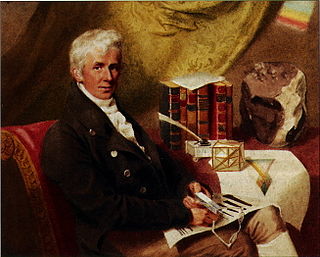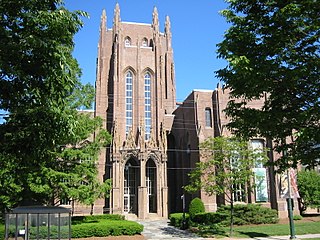
Natural history is a domain of inquiry involving organisms, including animals, fungi, and plants, in their natural environment, leaning more towards observational than experimental methods of study. A person who studies natural history is called a naturalist or natural historian.

The Natural History Museum in London is a museum that exhibits a vast range of specimens from various segments of natural history. It is one of three major museums on Exhibition Road in South Kensington, the others being the Science Museum and the Victoria and Albert Museum. The Natural History Museum's main frontage, however, is on Cromwell Road.

Robert Jameson FRS FRSE was a Scottish naturalist and mineralogist.

World Museum is a large museum in Liverpool, England which has extensive collections covering archaeology, ethnology and the natural and physical sciences. Special attractions include the Natural History Centre and a planetarium. Entry to the museum is free. The museum is part of National Museums Liverpool.

James Sowerby was an English naturalist, illustrator and mineralogist. Contributions to published works, such as A Specimen of the Botany of New Holland or English Botany, include his detailed and appealing plates. The use of vivid colour and accessible texts were intended to reach a widening audience in works of natural history. The standard author abbreviation Sowerby is used to indicate this person as the author when citing a botanical name.

The Museu Paraense Emílio Goeldi (MPEG) is a Brazilian research institution and museum located in the city of Belém, state of Pará, Brazil. It was founded in 1866 by Domingos Soares Ferreira Penna as the Pará Museum of Natural History and Ethnography, and was later named in honor of Swiss naturalist Émil August Goeldi, who reorganized the institution and was its director from 1894 to 1905. It is now the "main research center on natural systems and sociocultural processes of the Brazilian Amazon." The museum and zoological park are listed as protected sites by both the National Institute of Historic and Artistic Heritage (IPHAN) and the Department of Historic, Artistic and Cultural Heritage of the state of Pará.

Alexander Henry Haliday was an Irish entomologist. He is primarily known for his work on Hymenoptera, Diptera, and Thysanoptera, but worked on all insect orders and on many aspects of entomology.

The Natural History Museum in Lima, is Peru's most important museum of natural history. It was established in 1918 and belongs to the National University of San Marcos.

The Clarke Medal is awarded by the Royal Society of New South Wales, the oldest learned society in Australia and the Southern Hemisphere, for distinguished work in the Natural sciences.

The Journal of Natural History is a scientific journal published by Taylor & Francis focusing on entomology and zoology. The journal was established in 1841 under the name Annals and Magazine of Natural History and obtained its current title in 1967. The journal was formed by the merger of the Magazine of Natural History (1828–1840) and the Annals of Natural History and Loudon and Charlesworth's Magazine of Natural History.

The Harvard Museum of Natural History (HMNH) is a natural history museum housed in the University Museum Building, located on the campus of Harvard University in Cambridge, Massachusetts. It features 16 galleries with 12,000 specimens drawn from the collections of the University's three natural history research museums: the Harvard University Herbaria, the Museum of Comparative Zoology, and the Harvard Mineralogical Museum.

Frederick Vincent Theobald FES was an English entomologist and "distinguished authority on mosquitoes". During his career, he was responsible for the economic zoology section of the Natural History Museum, London, vice-principal of the South-Eastern Agricultural College at Wye, Kent, Professor of Agricultural Zoology at London University, and advisory entomologist to the Board of Agriculture for the South-Eastern district of England. He wrote a five volume monograph and sixty scientific papers on mosquitoes. He was recognised for his work in entomology, tropical medicine, and sanitation; awards for his work include the Imperial Ottoman Order of Osmanieh, the Mary Kingsley Medal, and the Victoria Medal of Honour, as well as honorary fellowships of learned societies.

The Museum of Natural History is a museum located in Belgrade, Serbia. It is one of the oldest specialized national institutions in Serbia, and is the only museum of this type in Serbia.

The Hungarian Natural History Museum in Budapest, dating back to 1802, houses the largest natural history collections of Hungary and the region.
The Leskean Cabinet is an 18th-century mineral and natural history collection conserved in the Natural History Museum in Dublin. It is a cabinet of mineralogy which was assembled by Nathaniel Gottfried Leske.

The Peabody Museum of Natural History at Yale University is one of the oldest, largest, and most prolific university natural history museums in the world. It was founded by the philanthropist George Peabody in 1866 at the behest of his nephew Othniel Charles Marsh, an early paleontologist. Most known to the public for its Great Hall of Dinosaurs, which includes a mounted juvenile Brontosaurus and the 110-foot-long (34 m) mural The Age of Reptiles. It also has permanent exhibits dedicated to human and mammal evolution; wildlife dioramas; Egyptian artifacts; and the birds, minerals, and Native Americans of Connecticut.
John Stuart Noyes is a Welsh entomologist.

Chrysogaster antitheus , the Short-haired Wrinkle Fly, is a fairly common species of syrphid fly found in North America. Hoverflies get their names from the ability to remain nearly motionless while in flight. The adults are also known as flower flies for they are commonly found around and on flowers, from which they get both energy-giving nectar and protein-rich pollen. The larvae in this genus are aquatic rat-tailed larvae.

The Department of Earth and Environmental Sciences at The University of Manchester is one of the oldest earth and environmental science departments in the UK. The Department takes roughly 100 new undergraduates and 140 postgraduates each year, and employs 90 members of academic staff, 41 postdoctoral researchers, 27 technical staff and 20 administrative staff.
Richard Weaver was a British entomological collector, taxidermist, and shoemaker, who is best known for the discovery of what has been called Weaver's Fritillary Boloria dia. He founded a Birmingham museum of natural history in 1832 which closed down in 1841.
















